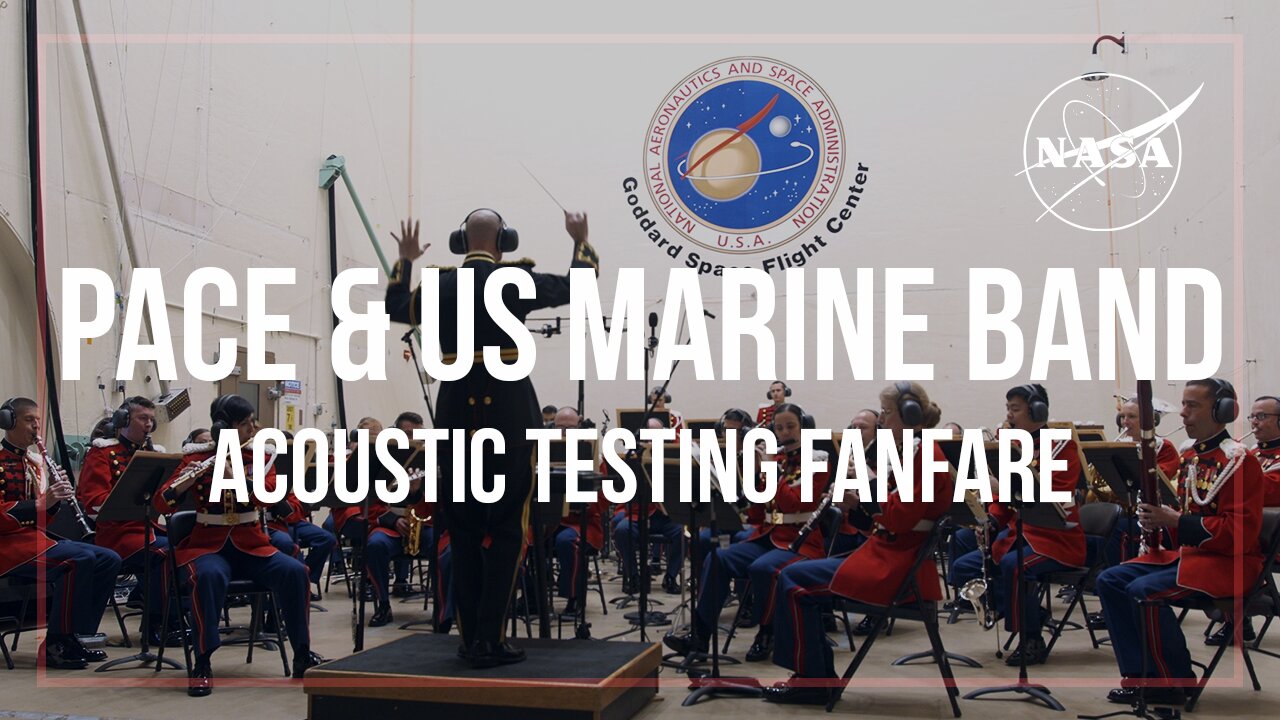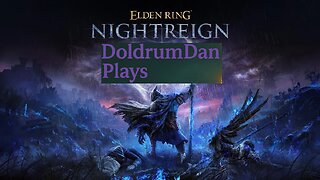Premium Only Content

PACE Mission Enlists The U.S.Marine Band For Acoustic Testing
Scientific Visualization Studio
5121: ODIAC: a map of human made carbon dioxide emissions
14349: NASA Interview Opportunity: Celebrate the James Webb Space Telescope’s First Year Of Amazing Science With a New Observation Live Shots
PACE Mission Enlists the United States Marine Band for Acoustic Testing Fanfare
Released Friday, June 30th, 2023
Updated Thursday, July 13th, 2023 at 9:50AM
Edited by:
Ryan Fitzgibbons
Scientific consulting by:
Gary Davis
Interviewees:
Gary Davis
Produced by:
Ryan Fitzgibbons
Videography:
Rob Andreoli
View full credits
Music: "Eternal Hope," "Power of Night," Universal Production Music
"Also Sprach Zarathustra," Composed by Richard Strauss, Performed by the United States Marine Band
"PACE Fanfare," Composed by Gunnery Sergeant Scott Ninmer, Performed by the United States Marine Band
Recorded sound courtesy of the U. S. Marine Band®. Use of the recorded sound does not constitute or imply endorsement by the Department of Defense, U. S. Marine Corps, or U. S. Marine Band®.
The terms U. S. Marine Band® and “The President’s Own®” are trademarks of the U. S. Marine Corps, used with permission.
The other works requested for use in this project are free and clear of any underlying copyright encumbrances and are in the public domain.
Neither the Marine Corps nor the Marine Band accept any responsibility for any use of Marine Band sound other than our own distribution.
Complete transcript available.
PACE Systems Engineer Gary Davis enlists the help of the United States Marine Band to see if musicians can match the acoustic levels the spacecraft is subjected to in testing.
Vertical version for Instagram Reels.
Music: "Eternal Hope," "Power of Night," Universal Production Music
"Ride of the Valkyries," Composed by Richard Wagner, Performed by the United States Marine Band
"Also Sprach Zarathustra," Composed by Richard Strauss, Performed by the United States Marine Band
"PACE Fanfare," Composed by Gunnery Sergeant Scott Ninmer, Performed by the United States Marine Band
Recorded sound courtesy of the U. S. Marine Band®. Use of the recorded sound does not constitute or imply endorsement by the Department of Defense, U. S. Marine Corps, or U. S. Marine Band®.
The terms U. S. Marine Band® and “The President’s Own®” are trademarks of the U. S. Marine Corps, used with permission.
The other works requested for use in this project are free and clear of any underlying copyright encumbrances and are in the public domain.
Neither the Marine Corps nor the Marine Band accept any responsibility for any use of Marine Band sound other than our own distribution.
Credits
Please give credit for this item to:
NASA's Goddard Space Flight Center
Editor
Ryan Fitzgibbons (KBRwyle) [Lead]
Scientist
Gary Davis (NASA) [Lead]
Interviewee
Gary Davis (NASA) [Lead]
Producer
Ryan Fitzgibbons (KBRwyle) [Lead]
Videographers
Rob Andreoli (AIMM) [Lead]
John D. Philyaw (AIMM)
Michael P. Menzel (AIMM)
Ryan Fitzgibbons (KBRwyle)
Project support
Jacob Richmond (NASA/GSFC) [Lead]
Technical support
Aaron E. Lepsch (ADNET)
Missions
This visualization is related to the following missions:
Plankton, Aerosol, Cloud, ocean Ecosystem (PACE)
Series
This visualization can be found in the following series:
Narrated Movies
You may also like...
ID: 14315 Produced Video
Tracking Carbon from Wildfires to Ocean Blooms
March 22nd, 2023
Music: "On the Trail," "Idle at Midnight," "Synthetic Comfort," Universal Production MusicComplete transcript available.Video descriptive text available.The following footage is provided by pond5.com through licensing and may not be excised: 00:00-00:12, 01:03-01:13, 01:15-01:23, 01:37-01:45, 02:07-02:21, 03:31-03:34, 03:43-03:47, 04:06-04:19, and 04:36-04:46 || Between September 2019 and March 2020, wildfires killed billions of animals and decimated more than 200 thousand square kilometers of Australian forest, an area larger than Nebraska. Later, thousands of kilometers away in the Southern Ocean, massive algae blooms covered a surface larger than the area of Australia itself. The connection between these major wildfires and the subsequent explosion of phytoplankton production is an example of the events NASA's upcoming Plankton, Aerosols, Clouds, and ocean Ecosystem (PACE) mission will help investigate. PACE's suite of instruments will allow scientists to get a clearer picture of carbon as it links land use and fires, atmospheric aerosols and marine communities, and ultimately improves those uncertain the data we put into climate models. ||
ID: 14236 Produced Video
PACE Integration and Testing Footage
Nov. 3rd, 2022
This is a collection of raw footage of the integration and testing of the instruments and spacecraft for the Plankton, Aerosols, Cloud, ocean Ecosystem (PACE) mission. || Beauty shots of the PACE spacecraft in the cleanroom with engineers. || Beauty shots of the PACE spacecraft in the cleanroom with engineers. || Integration of the SPEXone instrument on the PACE spacecraft. || Integration of the bus assembly. || Integration of the bus assembly. || Integration of the bus assembly. || Music: Morning Coffee by Anders Johan Gregor Lewen [STIM]Complete transcript available.Video descriptions available. ||
ID: 13523 Produced Video
Goddard Earth Science Overview
April 20th, 2020
NASA's Goddard Space Flight Center has the largest collection of Earth scientists on the planet. Their job is to be the nation's trusted source of comprehensive environmental information about the current state and the future of Earth. They build, design, launch and operate scientific missions, including satellites and airborne campaigns, as well as ground campaigns, to understand how the Earth works and how to predict how the Earth will change in the future.Complete transcript available.Watch this video on the NASA Goddard YouTube channel. ||
ID: 12066 Produced Video
Jeremy Werdell: Carbon and Climate Soundbite
Nov. 20th, 2015
Jeremy Werdell, oceanographer at NASA's Goddard Space Flight Center, discusses the importance of microscopic plankton in the global carbon cycle. With his colleagues, Jeremy is working to answer important questions about how much carbon dioxide the oceans are absorbing, and how that might change in the future.For complete transcript, click here.Music credit: Molecular by Mark Hawkins || Jeremy Werdell is studying how microscopic plankton in the oceans are responding to our changing climate. As a scientist at NASA’s Goddard Space Flight Center, he knows that Earth's oceans and land cover have been doing us a favor. As people burn fossil fuels and clear forests, only half of the carbon dioxide released stays in the atmosphere, warming and altering Earth’s climate. The other half is removed from the air by the planet’s vegetation ecosystems and oceans. But Jeremy and other scientists are still trying to answer important questions about how carbon dioxide emissions get absorbed by the land and the ocean — and how this could change in the future. Later this month, the United Nations climate meeting in Paris (Conference of Parties, aka COP-21) will focus on setting limits on future levels of human-produced carbon emissions. ||
ID: 14368 Produced Video
How NASA Observes Air Quality in DC
June 21st, 2023
16x9 version optimized for YouTube. Universal Production Music: Evolving Earth Underscore by James Carlin BakerThis video can be freely shared and downloaded. While the video in its entirety can be shared without permission, some individual imagery provided by Pond5.com is obtained through permission and may not be excised or remixed in other products. For more information on NASA’s media guidelines, visit https://www.nasa.gov/multimedia/guidelines/index.htmlComplete transcript available. || Take a Deep BreathThe air across the entire United States is cleaner than ever – but there’s more to do. NASA-supported scientist Susan Anenberg reviews air pollution data from satellites, airplanes, and ground sensors and combines it with data on race, ethnicity, poverty, and health. In doing so Anenberg unveils the both the big picture of air pollution and individual neighborhood effects. Information that lets community leaders and other decision makers to make better decisions and address long standing inequities. ||
ID: 14369 Produced Video
Leveraging NASA Research to Safeguard the U.S. East Coast from Hurricanes
June 21st, 2023
16x9 optimized for YouTube Music: Downloading Landscapes by Andrew Michael Britton & David Stephen Goldsmith and Swift Response by Miguel D' Oliveira This video can be freely shared and downloaded. While the video in its entirety can be shared without permission, some individual imagery provided by Pond5.com and NOAA is obtained through permission and may not be excised or remixed in other products. For more information on NASA’s media guidelines, visit https://www.nasa.gov/multimedia/guidelines/index.htmlComplete transcript available. ||
ID: 14367 Produced Video
NASA and Agriculture
June 15th, 2023
Feeding a Hungry World The farmers responsible for the food that reaches your plate need a lot of a very precious and limited resource, water. NASA works with farmers like Dwane Roth of Kansas to help them track their water use. Roth says that farmers like him are seeing more frequent, hotter days with less rain. “We need to grow more with less and get as much out of each drop of water we can,” he says. NASA helps to promote the use of Earth observations to strengthen food security. One solution is OpenET, a system that puts near-real-time water data into the hands of farmers in the United States. ||
ID: 14364 Produced Video
A Year in Climate
June 12th, 2023
Complete transcript available. || Understanding the Earth gives us the means to better protect it. Join NASA, as we monitor, study, and observe our planet 24 hours a day, 7 days a week, 365 days a year— to learn more and to protect and improve life on Earth.Music credit: “Ad Infinitum” from Universal Production Music ||
ID: 5088 Visualization
Tracking the Spread of the Caldor and Dixie Fires
June 12th, 2023
This visualization shows the spread of the Caldor and the Dixie fires in California during the summer of 2021, updated every 12 hours from a new fire detection and tracking approach based on near-real time active fire detections from the VIIRS sensor on the Suomi-NPP satellite.Complete transcript available. || This visualization highlights data from a new fire detection and tracking approach (Chen et al., 2022) based on near-real time active fire detections from the VIIRS sensor on the Suomi-NPP satellite. Every 12 hours, the fire tracking algorithm uses new active fire detections to update the total fire perimeter and estimate the position of active fire lines where the fire may continue to spread. This approach provides a detailed perspective on the behavior of the Caldor and Dixie fires, identifying periods of rapid fire expansion and active fire detections within the perimeter from continued flaming and smoldering behind the active fire fronts.The visualization shows the progression over time as the fire spreads. The yellow outlines track the position of the active fire lines every 12 hours for the last 60 hours, with the latest location of the fire front shown in the brightest shade of yellow. The red points show the location of active fire detections within the perimeter, while the grey region shows the estimated total area burned. The graph shows the cumulative burned area in square kilometers. ||
ID: 14386 Produced Video
Take Flight with NASA's STAQS Campaign
July 19th, 2023
Music credit: “Game Night Instrumental Wong” from Universal Production MusicStock footage: Pond5.comComplete transcript available. || NASA and NOAA’s STAQS campaign is taking to the skies and ground this summer to support TEMPO satellite data. Scientists will compare the air quality data they measure from planes with what TEMPO measures from orbit, making both measurements better. ||
Privacy Policy and Important Notices
Reproduction Guidelines
NASA Official: Mark SubbaRao
SVS Contact: Alex Kekesi
Site Curator: Eytan Kaplan
Web Page Design: Eytan Kaplan
-
 8:16
8:16
MattMorseTV
17 hours ago $9.24 earnedTrump’s name just got CLEARED.
82.5K80 -
 2:01:55
2:01:55
MG Show
21 hours agoPresident Trump Multilateral Meeting with European Leaders; Trump Outlines Putin Zelenskyy Meeting
32.4K21 -
 LIVE
LIVE
DoldrumDan
3 hours agoCHALLENGE RUNNER BOUT DONE WITH ELDEN RING NIGHTREIGN STORY MODE HUGE GAMING
69 watching -
 10:59
10:59
itsSeanDaniel
1 day agoEuropean Leaders INSTANTLY REGRET Disrespecting Trump
26.2K19 -
 16:43
16:43
GritsGG
17 hours agoThey Buffed This AR & It Slaps! Warzone Loadout!
27.7K1 -
 2:05:30
2:05:30
Side Scrollers Podcast
21 hours agoEveryone Hates MrBeast + FBI Spends $140k on Pokemon + All Todays News | Side Scrollers Live
120K15 -
 11:06
11:06
The Pascal Show
15 hours ago $1.68 earned'THEY'RE GETTING DEATH THREATS!' Jake Haro's Lawyer Breaks Silence On Emmanuel Haro's Disappearance!
22.4K4 -
 LIVE
LIVE
Lofi Girl
2 years agoSynthwave Radio 🌌 - beats to chill/game to
285 watching -
 2:19:32
2:19:32
Badlands Media
1 day agoDEFCON ZERO Ep. 005: False Flags, Cyber Fronts & Global Power Plays
164K80 -
 2:35:23
2:35:23
FreshandFit
11 hours agoWhy Black Men Don't Date Black Women Debate
49K52